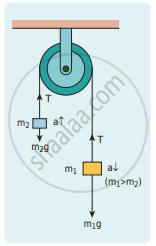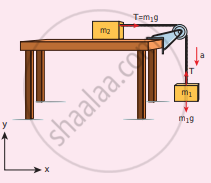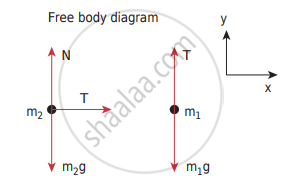Advertisements
Advertisements
Question
Explain the motion of blocks connected by a string in (i) Vertical motion (ii) Horizontal motion.
Solution
When objects are connected by strings and When objects are connected by strings and a force F is applied either vertically or horizontally or along an inclined plane, it produces a tension T in the string, which affects the acceleration to an extent. Let us discuss various causes for the same.
Case 1:
Vertical motion:
Consider two blocks of masses m1 and m2 (m1 > m2) connected by light and in-extensible string that passes over a pulley as shown in Figure.

Two blocks connected by a string over a pulley
Let the tension in the string be T and acceleration a. When the system is released, both the blocks start moving, m2 vertically upward and mk, downward with the same acceleration a. The gravitational force m1g on mass m1 is used in lifting the mass m2. The upward direction is chosen as y-direction. The free-body diagrams of both masses are shown in Figure.

Free body diagrams of masses m1 and m2
Applying Newton’s second law for mass `m_2Thatj - m_2ghatj = m_2ahatj` The left-hand side of the above equation is the total force that acts on m2 and the right-hand side is the product of mass and acceleration of m2 in the y-direction.
By comparing the components on both sides, we get
T = m2g = m2a ……….(1)
Similarly, applying Newton’s second law for mass m2
`Thatj - m_1ghatj = m_1ahatj`
As mass m1 moves downward (`-hatj`), its acceleration is along (`-hatj`)
By comparing the components on both sides, we get
T = m1g = -m1a
m1g – T = m1a ………..(2)
Adding equations (1) and (2), we get
m1g – m2g = m1a + m2a
(m1 – m2)g = (m1 + m2)a …………(3)
From equation (3), the acceleration of both the masses is –
a = `((m_1−m_2)/(m_1+m_2))`g ………..(4)
If both the masses are equal (m1 = m2), from equation (4)
a = 0
This shows that if the masses are equal, there is no acceleration and the system as a whole will be at rest.
To find the tension acting on the string, substitute the acceleration from equation (4) into equation (1).
T = m2g = m2`((m_1−m_2)/(m_1+m_2))`
T = m2g + m2 `((m_1−m_2)/(m_1+m_2))`g .............(5)
By taking m2g common in the RHS of equation (5)
T = `m_2g(1 + (m_1−m_2)/(m_1+m_2))`
T = `m_2g((m_1 + m_2 + m_1 - m_2)/(m_1 + m_2))`
T = `((2m_1m_2)/(m_1 + m_2))g`
Equation (4) gives only the magnitude of acceleration.
For mass m1, the acceleration vector is given by `veca = -(m_1−m_2)/(m_1+m_2)hatj`
For mass m2, the acceleration vector is given by `veca = (m_1−m_2)/(m_1+m_2)hatj`
Case 2:
Horizontal motion:
In this case, mass m2 is kept on a horizontal table and mass m1, is hanging through a small pulley as shown in the figure. Assume that there is no friction on the surface.

Blocks in the horizontal motion
As both the blocks are connected to the un stretchable string, if m1 moves with an acceleration downward then m2 also moves with the same acceleration horizontally.
The forces acting on mass m2 are
- Downward gravitational force (m2g)
- Upward normal force (N) exerted by the surface
- Horizontal tension (T) exerted by the string
The forces acting on mass m1 are
- Downward gravitational force (m1g)
- Tension (T) acting upwards
The free-body diagrams for both the masses are shown in the figure.

Free body diagrams of masses m1 and m2
Applying Newton’s second law for m1
`Thati - m_1ghatj = -m_1ahatj` (along y-direction)
By comparing the components on both sides of the above equation,
T – m1g = -m1a …………(1)
Applying Newton’s second law for m2
Ti = m1ai (along x-direction)
By comparing the components on both sides of the above equation,
T = m2a ………….(2)
There is no acceleration along y-direction for m2.
`Nhatj - m_2ghatj = 0`
By comparing the components on both sides of the above equation
N – m2g = 0
N = m2g ……….(3)
By substituting equation (2) in equation (1), we can find the tension T
m2a – m1g = -m1a
m2a + m1a = m1g
a = `(m_1)/(m_1+m_2)`g …………(4)
Tension in the string can be obtained by substituting equation (4) in equation (2)
T = `(m_1m_2)/(m_1+m_2)g` ………..(5)
Comparing motion in both cases, it is clear that the tension in the string for horizontal motion is half of the tension for a vertical motion for the same set of masses and strings. This result has an important application in industries. The ropes used in conveyor belts (horizontal motion) work for a longer duration than those of cranes and lifts (vertical motion).
APPEARS IN
RELATED QUESTIONS
When a car takes a sudden left turn in the curved road, passengers are pushed towards the right due to ______
A book is at rest on the table which exerts a normal force on the book. If this force is considered a reaction force, what is the action force according to Newton’s third law?
Explain the concept of inertia. Write two examples each for the inertia of motion, the inertia of rest, and inertia of direction.
State Newton’s second law.
Define one newton.
State Newton’s third law.
What are inertial frames?
State Newton’s three laws and discuss their significance.
